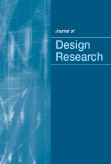Forthcoming and Online First Articles
Journal of Design Research

Forthcoming articles have been peer-reviewed and accepted for publication but are pending final changes, are not yet published and may not appear here in their final order of publication until they are assigned to issues. Therefore, the content conforms to our standards but the presentation (e.g. typesetting and proof-reading) is not necessarily up to the Inderscience standard. Additionally, titles, authors, abstracts and keywords may change before publication. Articles will not be published until the final proofs are validated by their authors.
Forthcoming articles must be purchased for the purposes of research, teaching and private study only. These articles can be cited using the expression "in press". For example: Smith, J. (in press). Article Title. Journal Title.
 Articles marked with this shopping trolley icon are available for purchase - click on the icon to send an email request to purchase.
Articles marked with this shopping trolley icon are available for purchase - click on the icon to send an email request to purchase.
Online First articles are published online here, before they appear in a journal issue. Online First articles are fully citeable, complete with a DOI. They can be cited, read, and downloaded. Online First articles are published as Open Access (OA) articles to make the latest research available as early as possible.
Register for our alerting service, which notifies you by email when new issues are published online.
J. of Design Research (2 papers in press) Regular Issues
Abstract: Human centred design approaches aim to generate better solutions through understanding peoples social, emotional, and physical needs. But how can designers centre humans in their design thinking? We propose a method for centring people during early idea generation: When creating design ideas and sketches, explicitly representing people may help designers think more deeply about how their designs impact people. We tested this method in two empirical studies using a short, solo idea generation task. Using a think-aloud protocol, student designers generated ideas for a presented problem both without instructions and then with an instruction to depict people in sketches. When people were represented in sketches, student designers reflected more about how people were impacted by their designs. These findings were replicated in a between-subjects experiment with mechanical engineering students. Results showed that representing people within design ideas led to considering more physical interactions, emotions, contexts, and stakeholder roles. Keywords: human-centred design; concept generation; conceptual sketching; ideation. DOI: 10.1504/JDR.2025.10070138 Navigating the nexus: towards a multidimensional framework for evaluating indoor spatial behaviour  by Selin Aktan Abraham, Deniz Deniz Abstract: Understanding spatial behaviour provides valuable insights into how people interact with built environments. However, comprehensive research focusing on indoor environments remains lacking due to the complexity of space-behaviour studies. This study addresses this gap by proposing a conceptual framework to evaluate indoor spatial behaviour through a mixedmethod approach. Key elements are identified using affinity diagramming and expert elicitation, and presented in a visual summary. The multi-dimensional assessment of indoor spatial behaviour (MAISB) framework includes three indicators (movement, perception, and configuration) and six dimensions (psychological, personal, socio-cultural, environmental, spatial, and temporal) encompassing 24 parameters. Findings show that the MAISB framework enhances understanding of the relationship between human behaviour and indoor environments, offering a structured approach for evaluating and improving spaces in future studies. This framework helps to build the theoretical foundation to integrate various elements of spatial behaviour, ensuring a holistic perspective on the design and evaluation of indoor environments. Keywords: spatial behaviour; indoor environment; multidisciplinary; conceptual framework; interior design. DOI: 10.1504/JDR.2025.10069690 |
 Open Access
Open Access